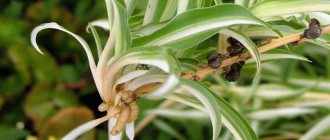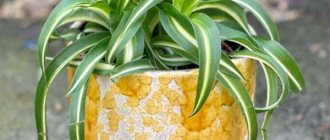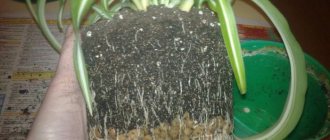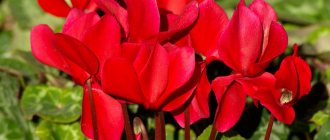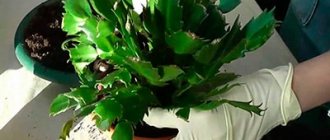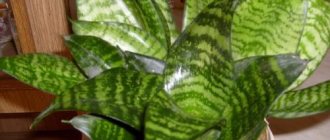- October 31, 2018
- Miscellaneous
- Marina Nikolaeva
Once upon a time, no more than twenty years ago, chlorophytum was one of the most popular indoor plants. It could be seen in almost every room of a house or apartment - in bright rooms, dark corridors, and the kitchen. This flower also decorated government institutions: in sanatoriums and hospitals, this tropical guest was comfortably located in the hallways; in schools, pots with it hung or stood in classrooms and corridors.
Unfortunately, today chlorophytum is undeservedly forgotten. In our opinion, it is completely in vain. The plant has remarkable decorative characteristics, does not require complex care, and is perfect for beginners who love indoor plants to gain experience. In this material we will tell you about this ornamental plant - how to care for it, water it, and how to replant chlorophytum.
Historical reference
An ornamental deciduous herbaceous plant - chlorophytum is a perennial epiphyte. In other words, in nature it grows on other plants without receiving nutrients from them. Initially, it was classified as a member of the Lily perennial family. Modern researchers do not have a consensus on this matter. One group of scientists classifies chlorophytum as a member of the Agave family, and another group as one of the Asparagus family.
Europeans learned how to grow chlorophytum more than 200 years ago, when plants were brought to the continent from the humid subtropics and tropics of Asia, Africa and South America. It is known that the brilliant German writer and philosopher Johann Goethe himself grew it in his home in hanging containers and always admired the spectacular appearance of the plants and the charming little children that hung around the mother bushes.
The name of the plant can be literally translated as “green plant.” In nature, in regions with high levels of humidity and heat, it is not easy for chlorophytum to survive. That is why this exotic guest feels so comfortable at home, giving the owner not only his beauty, but also useful and healing properties.
Problems when growing a plant
Problems when growing chlorophytum occur very rarely. Most often they are the result of improper care of an ornamental plant or lack thereof. The most common problems include drying out, yellowing or blackening of leaves, which can have various causes.
Drying leaf tips
Drying of the tips of chlorophytum leaves is most often accompanied by other unpleasant signs - lethargy, slow growth, faded foliage, loss of decorative appeal.
Common causes of drying and yellowing of chlorophytum leaves:
- No transfer. The rhizome of the plant grows rapidly. The flower pot becomes cramped for him, which leads to wilting, yellowing of the leaves, and slow growth.
- Using soil without prior fertilization. Poor soil does not saturate chlorophytum with all the beneficial substances necessary for its active growth and development. In this case, it is necessary to fertilize the ornamental plant. Complex organic or mineral fertilizers are used.
- High indoor temperature. To prevent the plant from drying out on hot summer days, it must be hidden from direct sunlight in a shaded place.
- Increased dryness of the air in the room is also dangerous for chlorophytum, as is incorrect temperature conditions. The plant needs to be provided with the required level of humidity and regular ventilation. At the same time, it should be protected from drafts, as they are destructive for it.
In some cases, the cause of dryness, yellowing and wilting of chlorophytum leaves is mechanical damage to the plant. It can be injured during transplantation into another container or the root system can be damaged when loosening the soil in a pot. Therefore, such procedures require special care and attention.
Blackening of the tips of chlorophytum
Many gardeners notice that the leaves of chlorophytum gradually acquire a brown-brown tint. Sometimes they become covered with dark spots and after a certain period of time become black.
In most cases, the cause of blackening of foliage is related to:
- with irregular loosening of the soil or its complete absence;
- increased soil moisture in a flower pot.
To prevent moisture stagnation, you need to strictly control the amount of watering of the flower. In the winter season, reduce them to a minimum, allowing the plant to “rest”.
It is recommended to resume watering in winter only after the top layers of soil in the flowerpot have dried. In some cases, darkening of chlorophytum leaves may be due to hypothermia. The pot with the plant is best placed in a warm place with diffused sunlight.
Useful properties of the plant
After numerous studies, scientists were able to prove that chlorophytum has a truly unique ability to remove formaldehyde, all kinds of toxins and impurities from the air around it. The phytoncides secreted by its leaves purify the air in the room from pathogenic microbes and saturate it with oxygen. It has been proven that in just a day, the flower kills about 80% of the bacteria in the air surrounding the bush. Three or four mature plants can easily clean a 10-square-meter room. m.
A flower placed on a kitchen windowsill absorbs harmful emissions from electrical and gas appliances. In the vicinity of pelargonium (indoor geranium), chlorophytum absorbs dust and microbes in rooms. For this feature it is often called a vacuum cleaner flower. The plant regulates the air humidity in the room and also improves its microclimate, since the leaf plates accumulate moisture and then release it into the surrounding atmosphere, being a kind of natural air humidifier.
By growing chlorophytum in your apartment, you can automatically improve your quality of life. This is especially important for people who suffer from bronchial asthma, allergies or low immunity.
To help a novice gardener, frequently asked questions
Tap water. The content of harmful impurities in water: chlorine and fluorine can harm the plant and burn the leaves.
Solution: water the flowers with settled water.
Failure to comply with watering rules. Both excessive watering and insufficient watering are equally bad and harmful for the plant.
Solution: put drainage at the bottom of the flowerpot or make holes for water outflow. In addition, it is better to purchase a soil moisture meter that will help control the watering process.
Pests. The most effective means of pest control are special preparations.
Solution: do not neglect preventive measures: thoroughly wash the flower pot before planting, use special, clean soil, or bake the soil in the oven.
Insufficient air humidity.
Solution: Use a humidifier. Another solution to the problem is to place the pot in a special tray, where pebbles or expanded clay are poured and a little water is poured.
It is important that the pot does not touch moisture
Why do Chlorophytum leaves turn yellow?
If the leaves of a plant first turn pale and then turn yellow, the reason is obvious - insufficient lighting.
Solution: Place the flower pot in a brighter window or provide an additional light source.
Cramped pot.
Solution: transplant into a new flower pot of larger diameter in the spring.
The lower leaves of chlorophytum die naturally over time.
What are the beneficial properties of chlorophytum?
Chlorophytum crested is a unique plant that can fight bacteria dangerous to human health. Also, the leaves of the plant actively fight toxins. To purify the air in one room, chlorophytum needs one day. Chlorophytum crested is a plant without special requirements, attractive with its decorative leaves. Looks great both in a single flowerpot and in flower arrangements.
External features of the plant
Chlorophytum has a short stem. The length of its leaves can vary depending on the variety. They are the longest (up to 60 cm or more) in hanging varieties. The narrow leaves with pointed ends have a linear-lanceolate shape, much less often – oval. They are collected in lush rosettes or bunches.
The bush grows in height and width approximately equally – by 50 cm. Cases have been recorded when an adult healthy plant grows up to a meter in height and in diameter, its leaves create magnificent cascades up to one and a half meters in length. On average, a perennial lives about 10 years.
Long shoots with aerial roots and small leaves grow from the center of the bush. In summer and spring, chlorophytum produces long, curved peduncles. At their ends appear small silvery-white star-shaped flowers, a bit like tiny lilies. They look very original against the background of long green or variegated leaves.
When the flowers fade, fruit boxes appear, as well as small rosettes with leaves and aerial roots. These are the children of chlorophytum. The flower has tuberous, thickened roots, colored brown or yellow. They can accumulate such an amount of moisture that the plant can live without watering or spraying for up to a month. In this case, your pet will lose its decorative appearance: the beautiful long leaves will fade and droop along the edges of the pot. However, the plant will not die, but will wait patiently until the owner remembers it. As soon as watering of chlorophytum is resumed, it will come to life again and very soon restore its attractiveness.
Chlorophytum signs and superstitions for the home
Houseplants have become a part of human life. They decorate our home and improve the microflora of the premises. When choosing a plant, people give preference to their taste; some like exotic plants, while others like flowering ones.
And more and more often people began to pay attention to the signs associated with this plant. And before buying a plant you should pay attention to this
Chlorophytum has many good qualities. This plant can often be found in factories.
Chlorophytum signs and superstitions for the home
Because of its sharp leaves, chlorophytum has acquired many different names such as: “green lily”, “flying Dutchman”. This flower is a perennial. Chlorophytum blooms very beautifully. The loose panicles are white and consist of small flowers. A large number of hanging stems with rosettes. Due to its ease of care, the flower takes root everywhere. Even if mistakes are made in caring for the plant, it will not cease to please its owners.
Variegated chlorophytum is widespread in our country; in addition to its beautiful appearance, it also has a positive effect on the human body. Chlorophytum improves the quality of oxygen in the room where it is located. This flower is recommended for people in polluted areas. The flower is able to destroy pollution, toxins, bacteria that are in the air. The plant releases substances that have a positive effect on the human body.
The flower is necessary for people with chronic colds and allergies. Chlorophytum purifies and humidifies the air. Some people grow the plant to combat mold and mildew on the walls. In a room where there is a microwave, TV, and computer, a flower is simply necessary. Four adult flowers can clean one room. It will also bring great benefits if you place it in the children's room and in the kitchen.
Chlorophytum signs to keep at home
There are many superstitions about the chlorophytum flower. The plant perceives the energy of the room in which it is located. Chlorophytum, even with proper care, will grow poorly if there is poor energy in the apartment. If there is a favorable environment in the family, peace and tranquility reigns, then the plant will smell fragrant. Chlorophytum is growing strongly, which means its owners are lucky or big changes await them. If someone has a bad influence on the owners of the house, then the flower becomes a shield for them. It attracts good luck, especially if it blooms; the more shoots it has, the stronger the effect. It also helps people prone to depression, those who have problems with their personal lives, or problems at work. Legends say that chlorophytum is able to arrange your personal life and introduce you to the right people. If there are constant conflicts and quarrels in the house, this miracle flower will bring peace to the house. You can often find chlorophytum in enterprises. People have several other interesting facts about the flower. They say that chlorophytum helps you absorb new information faster. This occurs due to the enrichment of oxygen in the room.
Types and varieties
Today there are more than two hundred species and varieties of this wonderful plant. However, only a few of them are common in indoor floriculture.
- Crested
It is a native of South Africa. Chlorophytum crested has long (up to 50 cm) saber-shaped leaves. White longitudinal stripes run along their edge. The leaves are collected in bunches, from the center of which arrows grow. They can be spread out or hanging, much less often - curly.
Daughter rosettes are formed at their ends. Initially, the leaves of this plant species were uniformly colored green. Later, varieties were developed with leaves decorated with longitudinal yellow-cream or white stripes in the center.
- Curly
This chlorophytum resembles a bush of dense grass with long and wider leaves that are covered with alternating light and dark green stripes. Hanging leaves curl at the ends. The flower looks very neat and compact. It forms simple inflorescences in the form of panicles.
- Winged (orange)
This species has unusually colored petioles on which the leaves are held. They are painted brick orange or orange-pink. The leaves are typical of chlorophytum - dark green and long. They taper towards the ends. As a rule, at home, propagation of this species of chlorophytum is carried out by seeds, much less often by root rosettes. The plant blooms with small orange flowers. Experienced flower growers recommend removing flower stalks in a timely manner so that the petioles do not lose their bright color.
Possible growing difficulties
The tips of the leaves turn brown (turn brown). The cause may be mechanical damage or lack of nutrition, or too warm and dry air.
Brown spots appear on the leaves. The cause may be excessive watering at high temperatures in winter.
The leaves are limp and pale. The cause may be excess heat and lack of light, or a lack of mineral nutrition.
The rosette of leaves began to rot. The reason may be that the soil is waterlogged due to too much watering, especially in winter, or due to a heavy substrate.
The leaves become dark green and lose their variegated color. The reason is lack of light, adjust it. On cloudy days, variegated forms require illumination with fluorescent lamps.
Lack of flower stalks. The reason may be that the plant is in too small a pot, or the plant is still very young.
Chlorophytums are rarely damaged by pests, but aphids, scale insects, and spider mites can attack a very weakened plant.
Chlorophytum: home care
Perhaps this is the most resilient and unpretentious indoor flower known today. This is why it is suitable for beginner gardeners - you will get excellent practice and will not be disappointed with the result.
Caring for chlorophytum at home is extremely simple: the plant can withstand any conditions - a dark corner or a bright window, regular watering or moistening once a month. By its appearance, chlorophytum informs its owner about a mistake. Moreover, he will give you time to fix it, and if you take this chance, he will again thank you with a magnificent decorative look. Nevertheless, we will introduce you to the conditions that are most comfortable for this flower.
Why does chlorophytum dry out?
For some novice gardeners, the home chlorophytum flower may begin to dry out with yellowing and dying leaves. This situation may occur when:
- Poor and heavy soil in a pot lacks essential microelements for the plant. Then you need to increase fertilizing or replant the flower.
- Incorrect watering mode. Perhaps the owner simply forgot about the need to moisten the plant.
- The air temperature is too high and the humidity in the room is too low. In this case, you need to increase the frequency of watering and add spraying of the plant from a spray bottle.
- A cramped pot in which the roots of the flower gradually replaced all the soil.
Lighting
For this light-loving plant, diffused lighting is quite comfortable. Chlorophytum grows and develops well in such conditions. He likes the location near western or eastern windows. It will also take root on a bright windowsill of a south-facing window, but in this case it should be slightly shaded at midday to protect the leaves from being burned.
Chlorophytum varieties with green leaves can grow even in dark corners. True, its flowers will not be as rich and smaller; in this case, the daughter rosettes develop less actively.
If you are interested in how to plant variegated chlorophytum, then it should be noted that it does not like too shaded places - quite quickly the bright stripes will disappear from the leaves and they will become monochromatic green.
Watering the plant
Our exotic guest loves moist soil. Abundant and frequent watering of chlorophytum is recommended from spring to autumn. In winter, moderate soil moisture is sufficient. During the heating season, the earthen ball dries out quite quickly even in winter, so try to keep it moist, avoiding waterlogging.
Unlike the overwhelming majority of indoor plants, chlorophytum, without being capricious, drinks tap water, which is left to settle for 24 hours. If the plant lacks moisture, the leaves begin to dry out and the roots become covered with additional tuberous thickenings. When overwatered, if there is always water in the tray, the tips of the leaves of the chlorophytum turn black and its appearance deteriorates.
Pests and diseases
I repeat like a mantra: if, when caring for a plant, you fulfill all the requirements of agricultural technology and if you treat all your plants responsibly, then diseases and pests will bypass your home flower garden. But, as they say, no one is immune from mistakes, so it’s better to assume the worst and be prepared for it.
So, among the pests that are dangerous for chlorophytum are thrips, nematodes, aphids, spider mites, and mealybugs. And if one of these insects appears on your plant, the first thing you should think about is: what did I do (or have done) wrong? Think about this while you are exterminating pests, and take all measures to avoid their second coming.
As for chlorophytum diseases (various spots, root rot and bacterial diseases), they arise solely due to violation of the rules of plant care. Let's look at what problems arise from what violations.
- Cabomba: keeping in an aquarium, types and photos
Chlorophytum dries
If the chlorophytum leaf dries only from the tip, then it is likely that the problem is excess sodium in the soil. Stop feeding the plant with fertilizers that contain sodium, and the plant will gradually recover. Sometimes chlorophytum turns black and dries from the end of the leaf, if the soil in the pot is dry for a long time in hot weather or the air humidity is not high enough - check your suspicions and eliminate the lack of care.
Chlorophytum turns yellow
There may be several reasons. Firstly, the lower leaves may turn yellow due to chronic waterlogging of the soil, as a result of which the roots rot. It is necessary to transplant the plant into fresh soil, first removing all rotten and blackened roots. And now you will have to pour water into the soil taking into account the experience gained.
Sometimes the leaves turn pale and yellow due to lack of lighting - move the chlorophytum closer to the window or organize artificial lighting. When the roots are crowded in the pot and the plant lacks nutrients, the leaves begin to signal this by gradually changing their color from green to yellow. Try to be attentive and quick-witted in order to be able to help the plant in time to get rid of the problems that it has developed due to your fault.
Well, a few more tips on how to rid your plant of diseases and their symptoms:
- brown spots on the leaves of chlorophytum - due to excessive watering at low indoor temperatures;
- wrinkled edges of brown leaves are caused by chronic drought of the top layer of soil;
- If in winter the leaves turn pale and fall off, it means that the chlorophytum is too hot and not light enough.
Choosing a flower container
Which pot is needed for chlorophytum is determined only by the owner of the plant. Only he decides in what container it is more convenient to grow a flower - in a flowerpot, in a pot, hanging varieties - in wicker hanging baskets and flowerpots. Chlorophytum grows well even in hydroponics. The root system of this plant will easily master a pot of any size and type. The only factor to consider is that ceramic pots or thick-walled flowerpots are more suitable for mature plants. Plastic pots with thin walls cannot withstand the powerful pressure of the root system and burst.
Soil selection
You don’t have to worry about what kind of soil is suitable for chlorophytum. The plant feels great in any universal soil composition for indoor plants. It is necessary that the substrate must be moisture-absorbing, well aerated and loose. In heavy soil, the plant most often slows down its growth, its root system is inhibited, and the above-ground part becomes less lush and elegant.
If you do not have the opportunity to buy ready-made soil, make it yourself from equal parts of leaf soil, turf soil, humus sand and peat.
Top dressing
Chlorophytum planted in soil for ornamental plants, as a rule, does not need feeding. However, experts recommend feeding chlorophytum twice a month in spring and summer with liquid fertilizer, which stimulates the plant to form daughter rosettes.
You will immediately notice from the faded and drying leaves that the composition of the soil mixture is too poor. Only weekly liquid feeding while watering the plant will help save the situation. Any complex fertilizer in the dose recommended by the instructions is suitable for this purpose.
Caring for chlorophytum: watering, fertilizing, temperature conditions
Any plant feels good in comfortable conditions for growth and development, chlorophytum is no exception. It’s easy to create the right conditions for a flower.
Temperature conditions for growing
The herbaceous plant is not picky about temperature conditions, but in winter it can get sick in a cold room. The optimal temperature for keeping a flower in winter is +18 degrees. In summer, it is useful to take the flower out into the fresh air, but protect it from the scorching sun. The temperature in the growing room should be within +25 degrees.
Important! The plant should not be exposed to cold air or drafts.
Therefore, in winter you need to carefully ventilate the room
Air humidity
Chlorophytum loves high air humidity. In summer, frequent spraying and warm showers are useful. In winter, the frequency of spraying is reduced. If the flower pot is located near central heating, then the plant needs to be irrigated in winter.
With insufficient humidity, chlorophytum often gets sick, the decorative effect of the flower is lost: the tips of the leaves dry out and die. You can increase the air humidity around a flower pot in different ways. One of them is to place the container in a container with water and expanded clay.
Important! You need to spray the flower in the morning so that the sun's rays do not burn the leaves. Watering
Watering
Chlorophytum is a moisture-loving plant. During the period of active growth, from early spring to autumn, the flower needs frequent watering. With the onset of the dormant period, the frequency of watering is reduced. However, the plant cannot be flooded, as this is fraught with putrefactive diseases.
For irrigation use settled warm water. Insufficient watering can be judged by the presence of compactions on the roots, falling leaves and dryness of the earthen clod. With a properly organized watering regime, the plant looks healthy, grows well and blooms profusely.
Feeding chlorophytum
The flower is very responsive to fertilization. From spring to autumn it can be fed with complexes for flowering plants. The frequency of fertilizing is 1-2 times a month. An overfed flower “fattens” and stops blooming, and also becomes susceptible to various diseases. Fertilizers should be applied in the morning or evening when watering, strictly observing the concentration of the solution
It is important to remember that young plants require less feeding than older large specimens.
Advice! You can prepare fertilizers for chlorophytum from banana peels. To do this, the peel of one banana is infused in a liter of water for 24 hours. This solution is suitable not only for feeding chlorophytum, but also for fertilizing all indoor flowers.
Rest period
The plant does not have a clearly defined rest period, but the flower still needs rest. As a rule, it is arranged in winter. At this moment, it is necessary to reduce the temperature so that the chlorophytum will lay new flower buds in the coolness.
It is impossible to grow a flower without a dormant period; it quickly depletes, loses its attractiveness and requires replacement with a new specimen.
How to transplant chlorophytum?
This perennial, which has a powerful root system, grows very actively. The roots of the plant quickly fill the container, displacing the soil. Therefore, it is important to know how to transplant chlorophytum. As a rule, this procedure is carried out in early spring. Prepare a pot in advance, 2-3 cm larger in diameter than the previous one.
Remove the plant from the pot, shake off the soil from the roots and, as far as possible, disassemble them with your hands and straighten them. Place a layer of drainage (2-4 cm) at the bottom of the new pot. Place the chlorophytum in a new container with fresh soil. While filling the pot with substrate, gently shake it to fill all the voids.
After replanting, chlorophytum should be watered abundantly so that all the soil is saturated. Drain excess moisture from the pan after some time. Place the plant in a place protected from sunlight. After three days you can move it to a permanent place.
It is possible to replant chlorophytum in the fall if you notice that the flower has become cramped in the pot. In a container that is too cramped, as well as in a container that is too spacious, the plant may refuse to bloom.
Basic landing rules
Just purchased chlorophytum should be left in the shipping container for 1.5-2 weeks to adapt to the microclimate of the room. Planting a plant in a pot, as well as further transplants, is carried out according to the following rules:
- a rapidly developing young flower needs annual replanting;
- the procedure is carried out in the spring, at the beginning of the active growth phase;
- after 4 years, chlorophytum grows slowly, so an adult flower is replanted once every 2-3 years;
- the old bush can be left in the pot twice a year, renewing the top layer of soil.
What soil should I plant in?
You can purchase soil for decorative deciduous crops with neutral acidity in the store. In acidic and alkaline soil, chlorophytum develops poorly and often gets sick. You can also prepare the soil yourself.
To do this you need to take:
- leaf soil - 2 parts;
- humus - 1 part;
- coarse river sand - 1 part;
- turf soil - 2 parts.
All components are thoroughly mixed. The result is loose, nutritious soil with good air and moisture permeability.
Reference! The sand is pre-disinfected using a solution of potassium permanganate or heat treatment.
What size pot should I buy?
Chlorophytum roots grow quickly, gradually occupying the entire volume of the pot. Therefore, they begin to look above the ground and even crawl out of the drainage holes.
When choosing a pot, you should consider several rules:
- In order for the root system to continue to fully develop, a new pot should be chosen 3-4 cm larger than the previous one.
- Clay is the preferred material. It absorbs excess moisture, preventing the soil from becoming waterlogged.
- There should be several drainage holes at the bottom of the pot to drain excess water. If there are none or there is only one, you should drill it yourself.
Reference! Some gardeners prefer to use shallow but wide flowerpots, arguing that the root system of chlorophytum is superficial.
Air babies
The simplest, and therefore the most popular, method of propagating chlorophytum. Although children greatly decorate the plant, an excessive number of them should be disposed of - too many offspring weaken the flower. You can root children year-round in one of three possible ways.
- Select the strongest rosette, carefully separate it from the mother plant with a disinfected sharp knife and place it in a glass of settled water for rooting. Soon the roots will appear and grow. When their length reaches 2 cm, transplant the young bush into the prepared pot. Overgrown roots are very brittle and fragile, they can easily be damaged during planting.
- Do not separate the selected strong and healthy shoot located at the end of the shoot from the bush. Bury it in a separate container placed nearby. When the baby takes root, the shoot needs to be cut off.
- If for some reason you don’t like this method, then you can cut off the baby from the frog and immediately bury it in a pot of soil. Water the seedling and cover with a bag or jar. The rosette will quickly take root, since at the base it has small aerial roots, from which a powerful root system will be formed.
About the propagation of chlorophytum
In theory, there are 3 possible methods for propagating chlorophytum, but in reality only 2 are used - division and propagation by daughter bushes.
Propagation by seeds is possible - this means germinating the plant from the very beginning, which is quite labor-intensive and ineffective.
Of the planted seedlings, no more than 40% of sprouts emerge.
Reproduction by division
If chlorophytum is already mature, it can be propagated by dividing the bush. This is easy to do - you just need to remove the entire root system from the pot, which will fill the entire volume. It is better to remove the roots from moist soil, so the flower is watered several hours before the procedure.
If possible, the removed flower is divided into several copies along with a lump of earth. A knife is used for this. Additionally, rotten areas must be removed before planting. The plant is simply planted in pots and covered tightly with soil.
Reproduction by daughter bushes
The daughter bushes play a more decorative role - they hang cutely on the stem, which, if possible, begins to bloom additionally in spring or summer. To propagate by bushes, you need to do the following:
- Cut the bush from the stem with a knife. It is also recommended to remove it in the future so that it does not spoil the appearance by drying out.
- The bush is placed in water for several days - after 3-4 days the first roots will appear.
- With roots, the bush is planted in suitable soil and cared for according to the same principle as described earlier.
If the daughter bush is large, it can be immediately planted in the soil, which is immediately moistened and the plant is cared for as usual.
Chlorophytum. Reproduction. Video:
Chlorophytum. Reproduction. [Hope and Peace]


